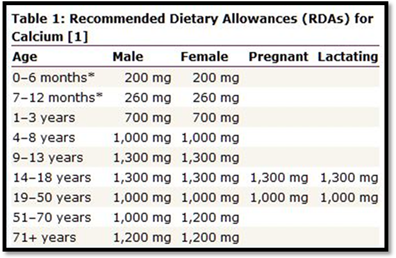
(a)
Interpretation:
Using the recommended daily dietary intake of calcium the amount of calcium required for adult men and premenopausal women should be identified.
Concept Introduction:
Importance of Calcium in diet:
- 1. Calcium is required by human body for muscle contraction, hormones release and transmission of messages via nerves.
- 2. Correct intake of calcium helps one from osteoporosis which occurs as density of the bone decreases and results in structural defect and weakness of bones.
(b)
Interpretation:
The mass of calcium citrate required to attain the recommended daily intake of calcium should be calculated.
Concept Introduction:
Calcium citrate: It is recommended for calcium deficiency diseases namely rickets, tetany and osteoporosis. The molecular formula of Calcium citrate is
Importance of Calcium in diet:
- 1. Calcium is required by human body for muscle contraction, hormones release and transmission of messages via nerves.
- 2. Correct intake of calcium helps one from osteoporosis which occurs as density of the bone decreases and results in structural defect and weakness of bones.
The table that depicts recommended daily intake of calcium is as follows,

Moles: One mole is equivalent to the mass of the substance consists same number of units equal to the atoms present in
The mole is actually quantity of particles that is
The sum of mass of all atoms present in formula of chemical substance is referred as molecular or formula weight of that substance.
Mass: It is the quantitative measure of a substance. The amount of matter present in substance is expressed as mass. The
Molar mass: It is obtained by dividing the mass of substance with the amount of substance and the S.I. unit of molar mass is
Want to see the full answer?
Check out a sample textbook solution
Chapter 6 Solutions
Fundamentals of General, Organic, and Biological Chemistry, Books a la Carte Plus Mastering Chemistry with Pearson eText -- Access Card Package (8th Edition)
- The following data were recorded for the enzyme catalyzed conversion of S -> P Question: what would the rate be at 5.0 x 10-5 M [S] and the enzyme concentration was doubled? Also, the rate given in the table is from product accumulation after 10 minuets of reaction time. Verify these rates represent a true initial rate (less than 5% turnover). Please helparrow_forwardThe following data was obtained on isocitrate lyase from an algal species. Identify the reaction catalyzed by this enzyme, deduce the KM and Vmax , and determine the nature of the inhibition by oxaloacetate. Please helparrow_forwardIn the table below, there are sketches of four crystals made of positively-charged cations and negatively-charged anions. Rank these crystals in decreasing order of stability (or equivalently increasing order of energy). That is, select "1" below the most stable (lowest energy) crystal. Select "2" below the next most stable (next lowest energy) crystal, and so forth. A B 鹽 (Choose one) +2 C +2 +2 (Choose one) D 鹽雞 (Choose one) (Choose one)arrow_forward
- 1. Draw the structures for the fats A. 16:2: w-3 and B. 18:3:49,12,15 2. Name each of the molecules below (image attached)arrow_forwarddraw the structures for the fats A. 16:2:w-3 B 18:3:9,12,15arrow_forward1. Below is a template strand of DNA. Show the mRNA and protein that would result. label the ends of the molecules ( refer to attached image)arrow_forward
- Attach the followina labels to the diagram below: helicase, single stranded binding proteins, lagging strand, leading strand, DNA polymerase, primase, 5' ends (3), 3' ends (3) (image attached)arrow_forward1. How much energy in terms of ATP can be obtained from tristearin (stearate is 18:0) Show steps pleasearrow_forwardMultiple choice urgent!!arrow_forward
 Principles Of Radiographic Imaging: An Art And A ...Health & NutritionISBN:9781337711067Author:Richard R. Carlton, Arlene M. Adler, Vesna BalacPublisher:Cengage Learning
Principles Of Radiographic Imaging: An Art And A ...Health & NutritionISBN:9781337711067Author:Richard R. Carlton, Arlene M. Adler, Vesna BalacPublisher:Cengage Learning





